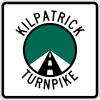|
Turnpikes of Oklahoma
Oklahoma has an extensive turnpike system, maintained by the state government through the Oklahoma Turnpike Authority. All of Oklahoma's turnpikes are controlled-access highways. The majority have at least four lanes, though the Chickasaw Turnpike is two lanes. Tolls on Oklahoma's turnpikes are collected through several methods, particular to each turnpike, involving mainline plazas. Tolls can either be paid by mail or through the Pikepass transponder system. In place of cash collection booths, PlatePay, a cashless pay-by-mail system, operates on all of the state's turnpikes, including the Kilpatrick Turnpike, Kickapoo Turnpike, and Creek Turnpike. As of November 2024, the entire turnpike system is cashless; the last toll booths at the Will Rogers Turnpike closed as part of the transition to PlatePay. Turnpikes
Surveyed but not builtShortly after the Turner Turnpike was built in 1953, the Oklahoma Turnpike Authority proposed other toll roads including one to be built from Oklahoma City north to the Kansas border near Braman to tie in with the southern terminus of the Kansas Turnpike at the state line. That routing was included as part of the Federal Highway Act of 1956 which created the Interstate Highway System. As a result, the OTA could not obtain financing to build that proposed turnpike and turned the initial plans including surveys and blueprints over to the Oklahoma Department of Transportation in 1956 for the construction of I-35 as a freeway on that same alignment, which was completed in several stages between 1958 and 1962. Also proposed but never built was a toll road roughly following what would later become I-35 between Oklahoma City and the Red River north of Gainesville, Texas that included a spur route veering from the main route north of Ardmore veering northeastward past Ada to tie in with the Turner Turnpike near Stroud, Oklahoma. Also proposed in the 1990s, but never built was an extension of the Muskogee Turnpike from its current southeastern terminus at I-40 southeastward toward Poteau. Proposed Turnpikes
Payment methodsPikepassPikepass is the electronic toll collection system used by the Oklahoma Turnpike Authority. Created in 1990 and launched on January 1, 1991, Pikepass provides an alternative to paying cash tolls.[3] Most customers pay an initial $40 in prepaid tolls, which they can refill at their own convenience or have funds automatically withdrawn to replenish the account if it falls below a threshold. Pikepass usage results in a 5% savings up front and customers with 20 or more uses of the Pikepass receive a credit of 5% of their toll charges for that month. InteroperabilityAs of June 2024, Pikepass can be used on all turnpikes in Kansas, Texas and most turnpikes in Florida and Colorado as well as Oklahoma.[4] Oklahoma turnpikes also accept all transponders from Kansas (K-TAG) and Texas (EZ TAG, TollTag, TxTag), and SunPass from Florida, and ExpressToll from Colorado. PlatePayOn July 25, 2021, toll collection booths on the Kilpatrick Turnpike were closed and replaced with the new cashless pay-by-mail system known as PlatePay. Customers using PlatePay travel in the same lanes as customers when passing through a toll plaza. Instead of the toll being deducted from an account, drivers are mailed an invoice for their toll which is paid through an online portal or by check. Due to added costs with the new system, PlatePay toll rates are 75 percent higher on average than the previous cash rates. On January 25, 2022, the Kickapoo Turnpike closed its toll collection booths to begin PlatePay operations.[5] On June 21, 2022, the H. E. Bailey Turnpike from Lawton to Oklahoma City and its spur to Norman went cashless.[6] The remainder of the turnpike from Lawton to Texas was converted on July 27, 2022. On August 16, 2022, the Chicksaw Turnpike went cashless. The Oklahoma Turnpike Authority plans to implement cashless tolling through PlatePay on all turnpikes by the end of 2024.[7][8] As of November 20, 2024, the conversion to cashless tolling is complete with the Will Rogers Turnpike from Tulsa to the Missouri state line being the last turnpike to do so. CriticismThe turnpike system has received criticism from many, most notably from Gary Richardson, former U.S. Attorney and candidate for Governor of Oklahoma in 2002 and 2018, who has called for the abolition of the Turnpike Authority. Critics have noted the lack of revenue from turnpikes that actually goes to the state of Oklahoma.[9][10] The OTA counters that it receives no tax money to maintain, operate, and pay off the turnpike system; and, if the state had to pay routine maintenance and capital rehabilitation on the turnpikes, the cost to the government would be an additional $105 million annually.[11] References
|
||||||||||||||||||
Portal di Ensiklopedia Dunia


